15 Different Types of Blasting Abrasives
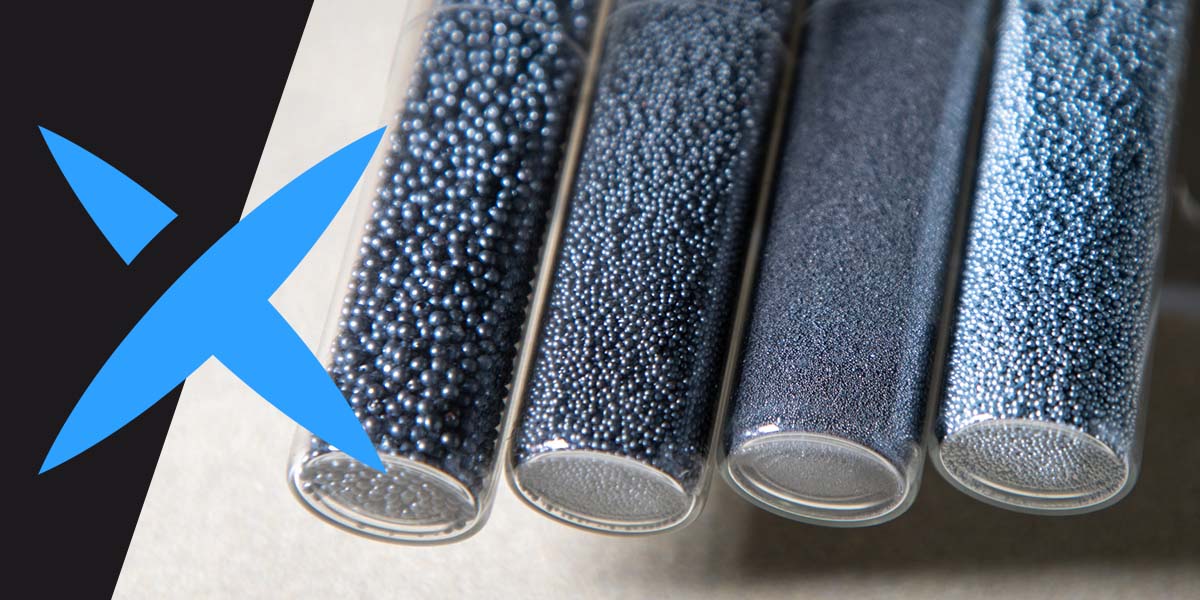
Abrasive blasting — sometimes referred to as sandblasting or media blasting — is an effective way to clean and prepare surfaces. As there are numerous blasting media types to choose from, you must determine the best material for your application.
Our guide provides an in-depth review of 15 of the most common types. Learn more about the benefits of each type so you can make the right selection for your project.
What Is Abrasive Blasting?
During abrasive blasting, workers use a blasting nozzle to direct their selected media onto the surface area, producing a smooth or rough finish. The technique is also popular for removing paint, rust, or scale from objects.
Businesses across industries use abrasive blasting in their operations, yet their applications differ vastly. For example, a food service business may use abrasive blasting to clean stainless steel equipment and bakeware, while a construction company can use blasting media for deburring concrete and preparing the surface for optimal coating adhesion.
No matter how you plan to use abrasive blasting, this process has many benefits, including:
- Eco-friendly options: Abrasive blasting can be more eco-friendly than chemical blasting, depending on the type of blasting media you use. Choosing this blasting method helps to reiterate your environmental responsibility.
- Operator safety: As there is less risk of chemical fumes with abrasive media, workers face fewer health and safety concerns.
- Efficiency: Abrasive blasting is highly effective on many surfaces, creating an efficient and scalable working process. Completing jobs at the onset helps you meet project deadlines while reducing excessive labor costs.
Identifying your project’s purpose is essential to choosing the best media for the task. Some materials are more hazardous than others, so you must also consider worker and environmental safety when deciding.
Different Blast Media Types
- Superoxalloy
- Silica Sand
- Baking Soda
- Slag
- Steel Shot
- Steel Grit
- Specular Hematite
- Aluminum Oxide
- Glass Beads
- Silicon Carbide
- Garnet Sand
- Walnut Shells
- Corn Cob
- Plastic Beads
- Dry Ice
What Can You Use for Abrasive Blasting?
Abrasive blasting media falls into two main groups — organic and inorganic. Within these categories, there are multiple blast media types to meet your surface requirements, environmental conditions, and desired finish. Here’s an overview of the 15 most popular types of media and their advantages.
1. Superoxalloy
As the product name implies, superoxalloy is a specially formulated alloy of oxide minerals. It primarily consists of mineral wool insulation byproduct. 10X Engineered Materials creates this innovative product from 100% recycled mineral wool insulation byproduct. The result is a non-crystalline substance that remains intact on impact. Abrasives that preserve their shape during use result in minimal embedment on the surface and, if desired, better recyclability.
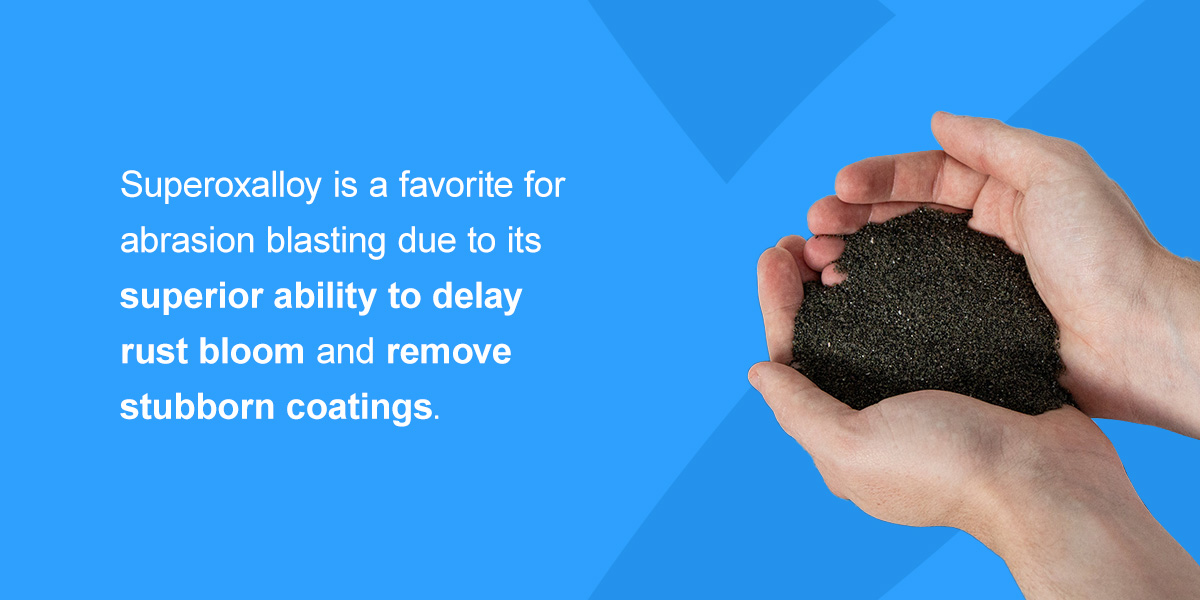
Superoxalloy is a favorite for abrasion blasting due to its superior ability to delay rust bloom and remove stubborn coatings. However, perhaps the greatest benefit of this media is that it delivers high performance while being more environmentally friendly. In comparison to common abrasives such as coal slag, copper slag and glass beads, superoxalloy blasting abrasives are certified safe by regulatory bodies such as the California Air Resources Board and the World Health Organization.
2. Silica Sand
Silica sand is a well-known blasting media — it is likely why so many people refer to abrasive blasting as sandblasting. Sand granules are uniform in shape, enabling them to deliver a consistent surface finish. Businesses in urban areas use this media to remove paint from surfaces such as sidewalks and decks. It is also particularly effective in removing graffiti from exterior walls.
Even though this media has been widely used for several years, industries are steering away from this option due to health concerns. Using sand in abrasive blasting exposes workers to free silica, which is linked to numerous health concerns, such as:
- Kidney issues
- Lung disease or other respiratory problems
- Chronic obstructive pulmonary disease
- Silicosis, which can cause disability or death
3. Baking Soda
The baking soda blasting method requires substantial dust containment and sodium bicarbonate. As the media is blasted onto the surface, the particles explode and remove residue and old coatings. It is a preferred media for softer surfaces, such as vehicle and boat exteriors.
Many projects require easy cleanup, and baking soda checks this box. Once the abrasion process is complete, teams can spray the area with water, and the media will dissolve. However, this media property means it is only for single use. Baking soda will not profile steel.
4. Slag
Slag is a collective term used to describe coal, copper, and nickel slags. Here’s an overview of each of these materials and their advantages:
- Coal: Power plants that burn coal produce a grain-like media called coal slag. It is effective in removing rust and paint from heavy machinery and agricultural equipment, helping extend their life spans.
- Copper: This media is a popular choice due to its higher density, making some blasting jobs more efficient than coal slag. Spending less time on job sites equates to reduced labor costs.
- Nickel: Nickel smelting produces a byproduct — a material known as nickel slag. Nickel slag is an effective product for cleaning surfaces, especially in preparation for new coatings and sealants.
These three media deliver good results, yet research connects them with severe health conditions. For example, copper is associated with cardiovascular and Alzheimer’s diseases. Similarly, coal and nickel slag have fallen out of favor due to their link to lung disease.
5. Steel Shot
Steel shot is spherical in composition. It is available in various sizes to suit your project and results in a smoother, peened finish. One of the most common applications for steel shot media is cleaning machinery or equipment that has signs of corrosion.
Many companies choose this option as it produces minimal dust, making it safer for workers. Its superior recyclability also allows workers to reuse it numerous times. However, as steel is on the higher end of the pricing spectrum, this media is often more expensive to purchase.
6. Steel Grit
Steel grit is another hardy media, making it ideal for removing old paint and rust from agricultural equipment and heavy machinery. It comprises of small, angular steel pieces which are actually manufactured by crushing steel shot. Steel grit offers a low dust blasting capabilities on various steel surfaces. But it cannot be used on aluminum surfaces.
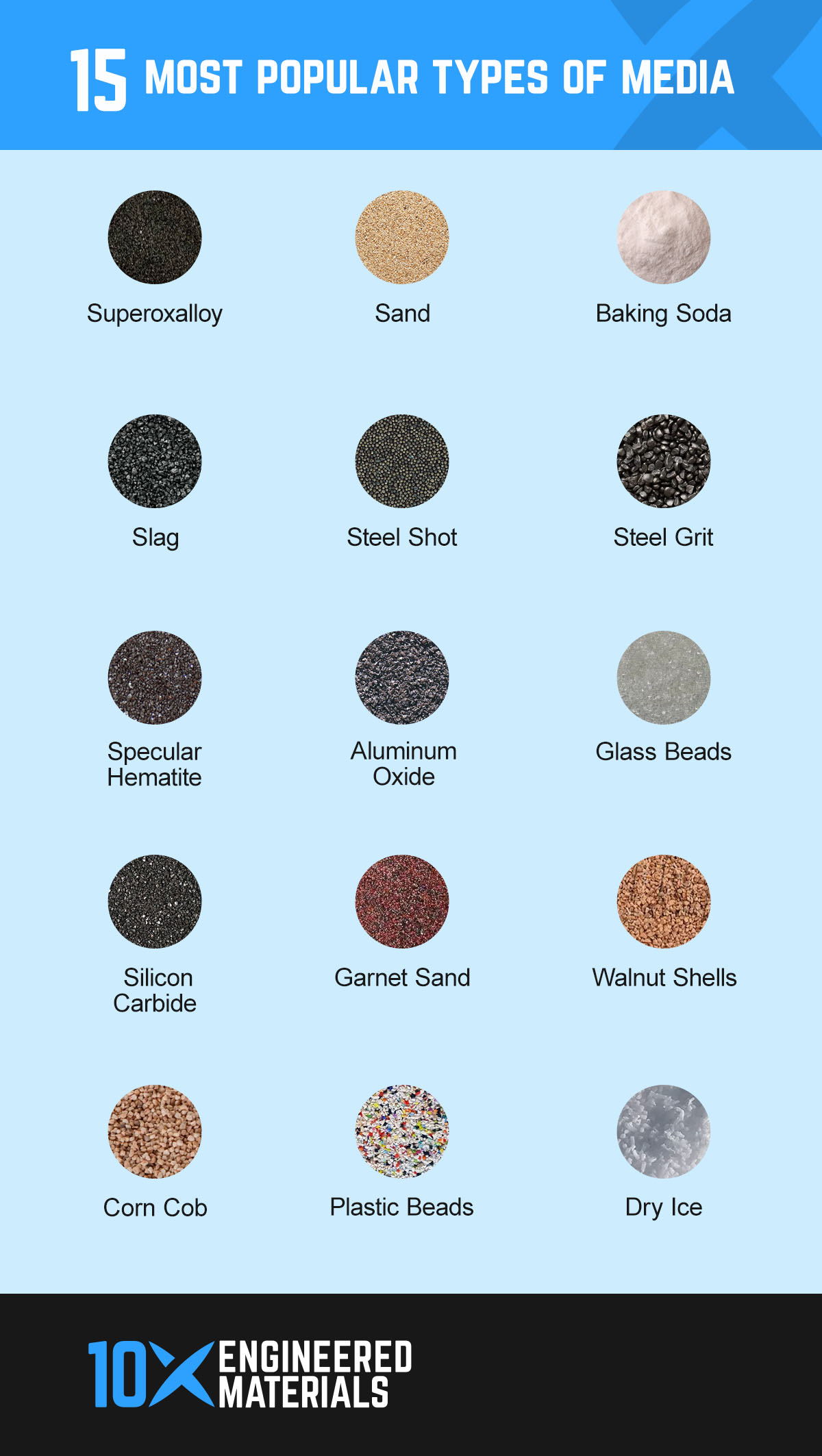
Despite its higher cost, steel grit is a popular media choice due to its superior recyclability, which also allows workers to reuse it numerous times. Steel grit does have high embedment, rapid flash rusting, and causes rapid wear and tear on all of your consumables, so for applications hoping to extend equipment lifespans it is not the best choice.
7. Specular Hematite
Specular hematite, also known as iron oxide, has a unique chemical composition compared to abrasive materials like sand. Additionally, unlike some other blasting media, specular hematite has a moderate hardness level. Its substantial density makes it a good choice for heavy-duty applications. It is iron oxide, so it is a less common abrasive, but it has a few specialty applications.
8. Aluminum Oxide
Aluminum oxide is a crystal-like substance that is either white or brown. Its hard-cutting properties make it a suitable media for strong metals such as steel. Aluminum oxide is regarded as a more aggressive form of abrasion, yet it delivers an even finish.
Another feature of this blasting media is that it produces less dust during blasting operations. Reduced dust onsite offers the dual benefit of making the cleaning process easier while ensuring better visuality during operations. Enhanced visuality enables teams to complete jobs faster, corresponding to less labor costs.
9. Glass Beads
Glass beads are spherical, which when coupled with air pressure, are effective in removing some residues and cleaning objects. Each glass bead size delivers a slightly different finish. Glass beads do not have the cutting power to work in industrial applications however, and are most commonly used as a secondary polishing or finishing process within a multi-step blasting or finishing process.
10. Silicon Carbide
Some projects require hard-cutting media, growing the demand for heavy-duty abrasive blasting options. Silicon carbide is one of the hardest blast media types. Miners source this mineral in moissanite, and it possesses strength properties similar to that of a diamond.
The hardy silicon carbide particles ensure a fast cutting speed, which equates to a shorter blast time. Spending less time on a job ultimately frees up your schedule to accept more business. However, this is an expensive abrasive that is generally only deployed when other products are unable to get the job done.
11. Garnet Sand
Garnet sand deposits can be found worldwide, making this abrasive widely accessible. It is a popular media choice as it is somewhat recyclable and relatively cost-effective. However, it has a higher level of particle embedment and causes steel to flash rush very quickly.
Although this media option is usually considered safe for the environment, the process of extracting it is not. Mining the earth’s surface requires substantial resources and can trigger air and water pollution, as well as soil degradation due to deforestation, contributing to serious ecological issues.
12. Walnut Shells
When faced with an unknown surface, it’s best to start with a softer media. Crushed walnut shells are a natural, lightweight media that offers an ideal solution for undiscovered surfaces. As this media is a byproduct of a natural substance, it’s both non-toxic and environmentally friendly.
Walnut shells are an effective option for applications that require you to remove a top coat without damaging underlying coatings or sealers. It will not leave a profile in steel. However, as walnuts fall within one of the most pertinent food allergen groups, workers will need to be mindful of any allergies within their team.
13. Corn Cob
Whether you are deburring a surface or polishing it, corn cob is the desired weight and shape for a multitude of surfaces. This biodegradable media is also a good choice for applications that require food-safe properties. For example, water systems that require cleaning cannot come into contact with toxic materials — corn cob offers a potential solution.
Overall, this eco-friendly option is best for softer materials such as wood, thin metals, and plastics, as it will remove some coatings without damaging the surface. Corn cob will not profile steel.
14. Plastic Beads
Unlike glass or metal beads, plastic beads are softer, making them ideal for lightweight or thin metal applications. Their material properties also make them resistant to rust, allowing industries to use them for extended periods.
One consideration regarding plastic beads is the cleanup. As it’s not always possible to collect all media after a project, these small plastic fragments could pose a risk to the surrounding environment and wildlife. Additionally, plastics take a long time to decompose, resulting in long-term ecological concerns. Plastic beads will not profile steel.
15. Dry Ice
Dry ice blasting combines carbon dioxide pellets and high-velocity air. The pellets are not sharp, making them a natural choice suitable for applications needing cleaning but not profiling. As dry ice is soft, it will not profile steel.
Regulations in the food industry enforce strict food-safe conditions, and dry ice is compatible with these requirements. Its biodegradable and non-reactive nature makes it a popular method for cleaning food processing equipment and metal bakeware. Similarly, dry ice is gentle enough for applications that require precision, such as cleaning electrical components. Caution: do not use dry ice in confined spaces due to the risks of asphyxiation from a lack of oxygen.
How to Determine Which Blasting Abrasive Is Best for You
The media you choose has a pivotal impact on your project results. These are some of the factors to consider when choosing a media to sandblast with for your next project:
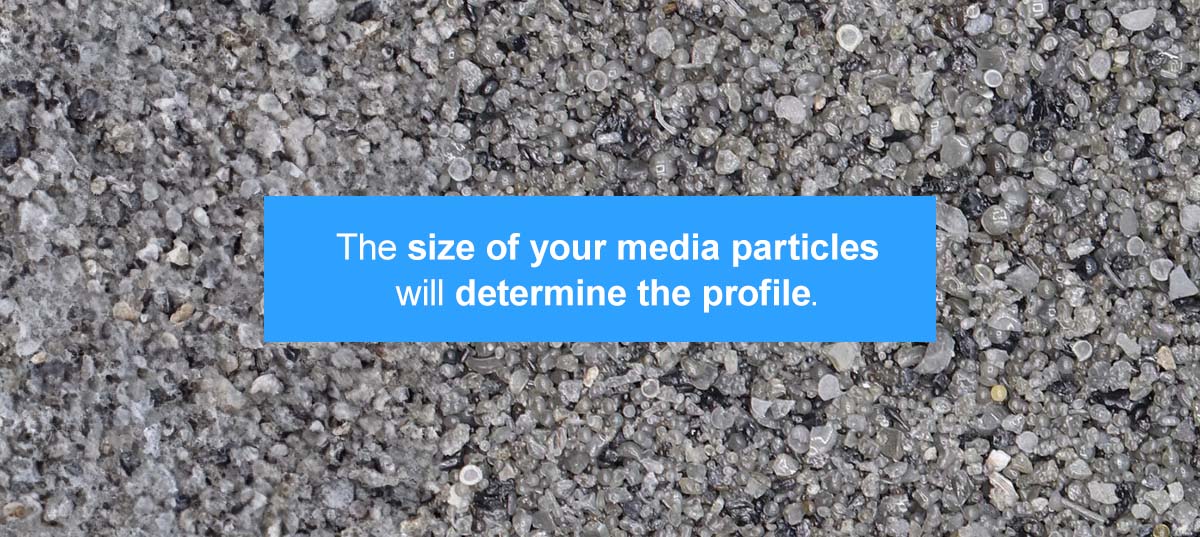
- Profile depth requirements: The size of your media particles will determine the profile. Larger media, such as large steel grit, will create deeper craters, whereas some smaller particles may leave no profile at all. Identify the profile you require and choose your media accordingly.
- Cleanliness requirements: Some abrasives cannot achieve a white metal finish. Check what surface cleanliness standards you require and avoid abrasives that cannot achieve that level of cleanliness in one pass, or you will add to your job completion time and costs.
- Dust level: Different media produce varying levels of dust. This is a concern for two reasons — worker health and environmental regulations. If your project is in an urban area, you may need to be more mindful about selecting a media that offers less dust.
- Flash rusting delay needs: Certain metals develop signs of rust minutes after water exposure. Some media are free of contaminants, which consequently limit rust bloom.
- Environmental impact: Making more eco-friendly business decisions benefits the environment. However, it can also benefit your bottom line, as many consumers highly value sustainable companies and products. Choosing sustainable media is an effective way to communicate your stance on eco-friendly practices.
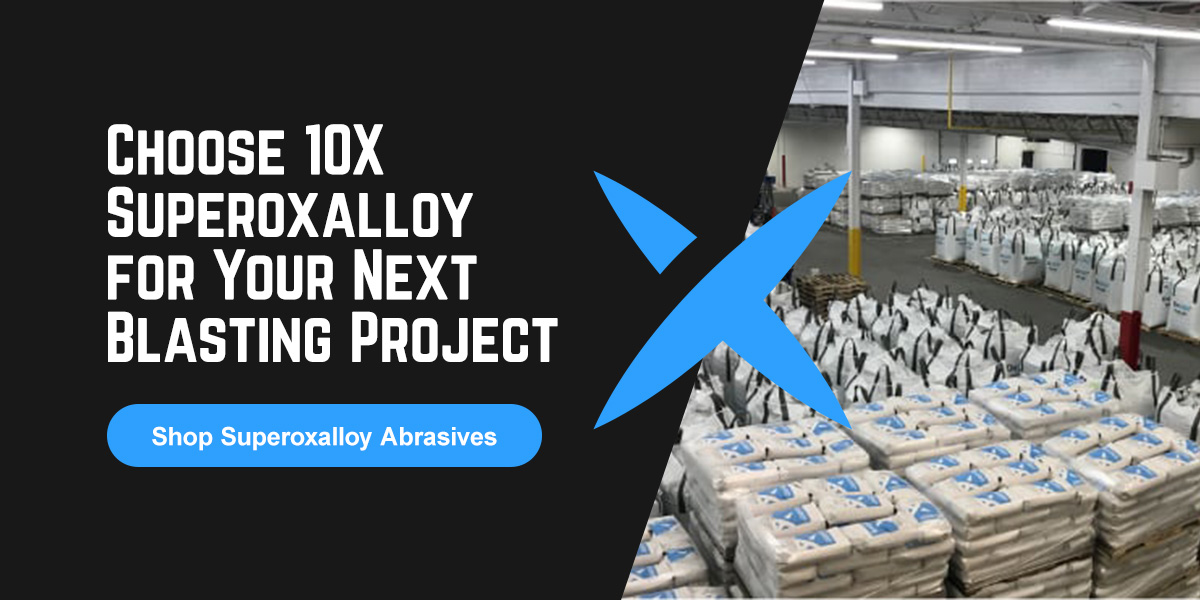
Choose 10X Superoxalloy for Your Next Blasting Project
Today, numerous sandblasting media types exist to achieve your desired finish on different surfaces. Advanced research into the effects of blasting media on worker health has also prompted a new generation of abrasive products that are safer for people and the environment.
10X Engineered Materials has made it our mission to formulate a cost-effective media solution that delivers superior results across applications. Our superoxalloy abrasives are the result of the latest engineering and scientific concepts, making it safer and more sustainable than many other options on the market.
Browse our range of superoxalloy blasting media today. Get in touch with our professional team to learn more about how 10X Engineered Materials can assist your project needs.
